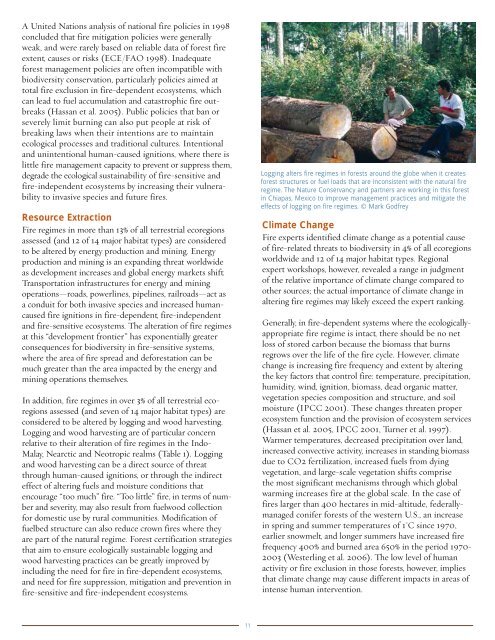Threats and Strategies for Global Biodiversity Conservation
Threats and Strategies for Global Biodiversity Conservation
Threats and Strategies for Global Biodiversity Conservation
Create successful ePaper yourself
Turn your PDF publications into a flip-book with our unique Google optimized e-Paper software.
A United Nations analysis of national fire policies in 1998concluded that fire mitigation policies were generallyweak, <strong>and</strong> were rarely based on reliable data of <strong>for</strong>est fireextent, causes or risks (ECE/FAO 1998). Inadequate<strong>for</strong>est management policies are often incompatible withbiodiversity conservation, particularly policies aimed attotal fire exclusion in fire-dependent ecosystems, whichcan lead to fuel accumulation <strong>and</strong> catastrophic fire outbreaks(Hassan et al. 2005). Public policies that ban orseverely limit burning can also put people at risk ofbreaking laws when their intentions are to maintainecological processes <strong>and</strong> traditional cultures. Intentional<strong>and</strong> unintentional human-caused ignitions, where there islittle fire management capacity to prevent or suppress them,degrade the ecological sustainability of fire-sensitive <strong>and</strong>fire-independent ecosystems by increasing their vulnerabilityto invasive species <strong>and</strong> future fires.Resource ExtractionFire regimes in more than 13% of all terrestrial ecoregionsassessed (<strong>and</strong> 12 of 14 major habitat types) are consideredto be altered by energy production <strong>and</strong> mining. Energyproduction <strong>and</strong> mining is an exp<strong>and</strong>ing threat worldwideas development increases <strong>and</strong> global energy markets shift.Transportation infrastructures <strong>for</strong> energy <strong>and</strong> miningoperations—roads, powerlines, pipelines, railroads—act asa conduit <strong>for</strong> both invasive species <strong>and</strong> increased humancausedfire ignitions in fire-dependent, fire-independent<strong>and</strong> fire-sensitive ecosystems. The alteration of fire regimesat this “development frontier” has exponentially greaterconsequences <strong>for</strong> biodiversity in fire-sensitive systems,where the area of fire spread <strong>and</strong> de<strong>for</strong>estation can bemuch greater than the area impacted by the energy <strong>and</strong>mining operations themselves.In addition, fire regimes in over 3% of all terrestrial ecoregionsassessed (<strong>and</strong> seven of 14 major habitat types) areconsidered to be altered by logging <strong>and</strong> wood harvesting.Logging <strong>and</strong> wood harvesting are of particular concernrelative to their alteration of fire regimes in the Indo-Malay, Nearctic <strong>and</strong> Neotropic realms (Table 1). Logging<strong>and</strong> wood harvesting can be a direct source of threatthrough human-caused ignitions, or through the indirecteffect of altering fuels <strong>and</strong> moisture conditions thatencourage “too much” fire. “Too little” fire, in terms of number<strong>and</strong> severity, may also result from fuelwood collection<strong>for</strong> domestic use by rural communities. Modification offuelbed structure can also reduce crown fires where theyare part of the natural regime. Forest certification strategiesthat aim to ensure ecologically sustainable logging <strong>and</strong>wood harvesting practices can be greatly improved byincluding the need <strong>for</strong> fire in fire-dependent ecosystems,<strong>and</strong> need <strong>for</strong> fire suppression, mitigation <strong>and</strong> prevention infire-sensitive <strong>and</strong> fire-independent ecosystems.Logging alters fire regimes in <strong>for</strong>ests around the globe when it creates<strong>for</strong>est structures or fuel loads that are inconsistent with the natural fireregime. The Nature Conservancy <strong>and</strong> partners are working in this <strong>for</strong>estin Chiapas, Mexico to improve management practices <strong>and</strong> mitigate theeffects of logging on fire regimes. © Mark GodfreyClimate ChangeFire experts identified climate change as a potential causeof fire-related threats to biodiversity in 4% of all ecoregionsworldwide <strong>and</strong> 12 of 14 major habitat types. Regionalexpert workshops, however, revealed a range in judgmentof the relative importance of climate change compared toother sources; the actual importance of climate change inaltering fire regimes may likely exceed the expert ranking.Generally, in fire-dependent systems where the ecologicallyappropriatefire regime is intact, there should be no netloss of stored carbon because the biomass that burnsregrows over the life of the fire cycle. However, climatechange is increasing fire frequency <strong>and</strong> extent by alteringthe key factors that control fire: temperature, precipitation,humidity, wind, ignition, biomass, dead organic matter,vegetation species composition <strong>and</strong> structure, <strong>and</strong> soilmoisture (IPCC 2001). These changes threaten properecosystem function <strong>and</strong> the provision of ecosystem services(Hassan et al. 2005, IPCC 2001, Turner et al. 1997).Warmer temperatures, decreased precipitation over l<strong>and</strong>,increased convective activity, increases in st<strong>and</strong>ing biomassdue to CO2 fertilization, increased fuels from dyingvegetation, <strong>and</strong> large-scale vegetation shifts comprisethe most significant mechanisms through which globalwarming increases fire at the global scale. In the case offires larger than 400 hectares in mid-altitude, federallymanagedconifer <strong>for</strong>ests of the western U.S., an increasein spring <strong>and</strong> summer temperatures of 1˚C since 1970,earlier snowmelt, <strong>and</strong> longer summers have increased firefrequency 400% <strong>and</strong> burned area 650% in the period 1970-2003 (Westerling et al. 2006). The low level of humanactivity or fire exclusion in those <strong>for</strong>ests, however, impliesthat climate change may cause different impacts in areas ofintense human intervention.11
















